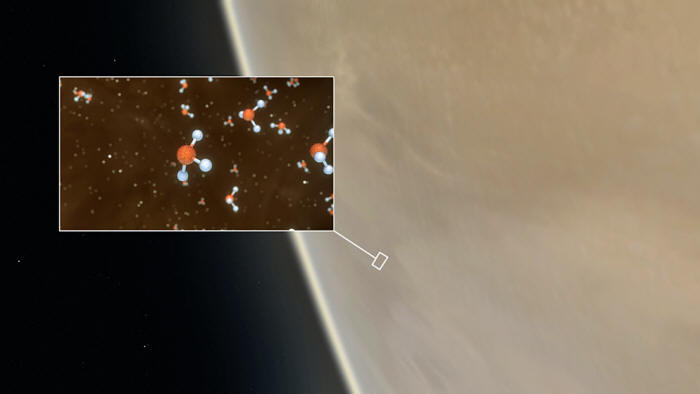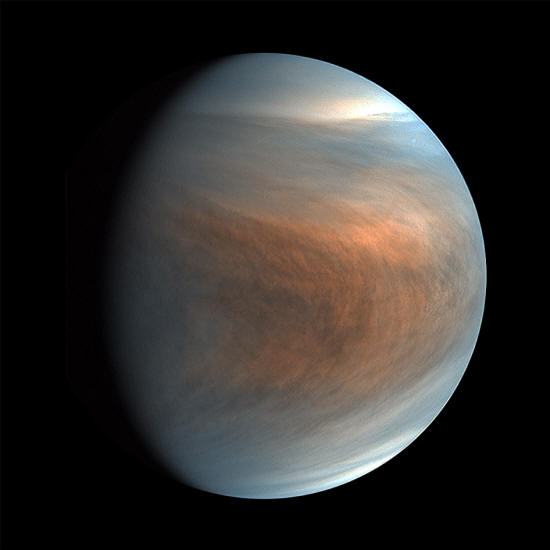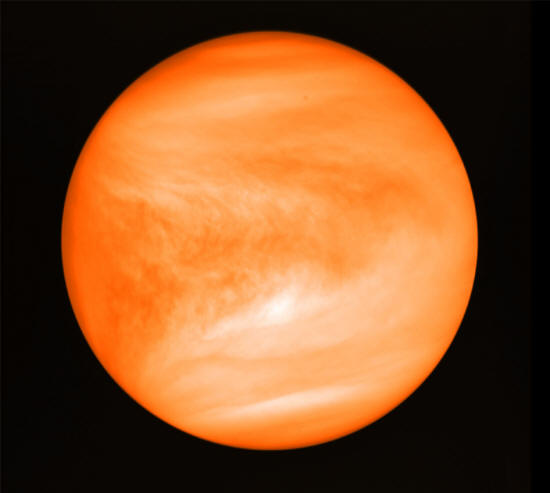|
by Press Press
with an inset showing a representation of the phosphine molecules detected
in the
high cloud decks.
L.
Calšada & NASA / JPL / Caltech
An international team of astronomers, led by Professor Jane Greaves of Cardiff University, today announced the discovery of a rare molecule - phosphine - in the clouds of Venus.
Astronomers have speculated for decades that high clouds on Venus could offer a home for microbes - floating free of the scorching surface, but still needing to tolerate very high acidity.
The detection of phosphine molecules, which consist of hydrogen and phosphorus, could point to this extra-terrestrial 'aerial' life.
The new discovery is described in a paper in Nature Astronomy.
The team first used the James Clerk Maxwell Telescope (JCMT) in Hawaii to detect the phosphine, and were then awarded time to follow up their discovery with 45 telescopes of the Atacama Large Millimeter/submillimeter Array (ALMA) in Chile.
Both facilities observed Venus at a wavelength of about 1 millimeter, much longer than the human eye can see - only telescopes at high altitude can detect this wavelength effectively.
Professor Greaves says,
Naturally cautious about the initial findings, Greaves and her team were delighted to get three hours of time with the more sensitive ALMA observatory.
Bad weather added a frustrating delay, but after six months of data processing, the discovery was confirmed.
Team member Dr. Anita Richards, of the UK ALMA Regional Centre and the University of Manchester, adds:
Greaves adds:
Professor Hideo Sagawa of Kyoto Sangyo University then used his models for the Venusian atmosphere to interpret the data, finding that phosphine is present but scarce - only about twenty molecules in every billion.
The astronomers then ran calculations to see if the phosphine could come from natural processes on Venus. They caution that some information is lacking - in fact, the only other study of phosphorus on Venus came from one lander experiment, carried by the Soviet Vega 2 mission in 1985.
Massachusetts Institute of Technology scientist Dr. William Bains led the work on assessing natural ways to make phosphine. Some ideas included sunlight, minerals blown upwards from the surface, volcanoes, or lightning, but none of these could make anywhere near enough of it.
Natural sources were found to make at most one ten thousandth of the amount of phosphine that the telescopes saw.
To create the observed quantity of phosphine on Venus, terrestrial organisms would only need to work at about 10% of their maximum productivity, according to calculations by Dr. Paul Rimmer of Cambridge University.
Any microbes on Venus will likely be very different to their Earth cousins though, to survive in hyper-acidic conditions.
Earth bacteria can absorb phosphate minerals, add hydrogen, and ultimately expel phosphine gas. It costs them energy to do this, so why they do it is not clear.
The phosphine could be just a waste product, but other scientists have suggested purposes like warding off rival bacteria.
Another MIT team-member, Dr. Clara Sousa Silva, was also thinking about searching for phosphine as a 'biosignature' gas of non-oxygen-using life on planets around other stars, because normal chemistry makes so little of it.
She comments:
Other possible biosignatures in the Solar System may exist, like methane on Mars and water venting from the icy moons Europa and Enceladus.
On Venus, it has been suggested that dark streaks where ultraviolet light is absorbed could come from colonies of microbes.
The Akatsuki spacecraft, launched by the Japanese space agency JAXA, is currently mapping these dark streaks to understand more about this "unknown ultraviolet absorber".
The team believes their discovery is significant because they can rule out many alternative ways to make phosphine, but they acknowledge that confirming the presence of "life" needs a lot more work.
Although the high clouds of Venus have temperatures up to a pleasant 30 degrees centigrade, they are incredibly acidic - around 90% sulphuric acid - posing major issues for microbes to survive there.
Professor Sara Seager and Dr. Janusz Petkowski, also both at MIT, are investigating how microbes could shield themselves inside droplets.
The team are now eagerly awaiting more telescope time, for example to establish whether the phosphine is in a relatively temperate part of the clouds, and to look for other gases associated with life.
New space missions could also travel to our neighboring planet, and sample the clouds in situ to further search for signs of life.
Professor Emma Bunce, President of the Royal Astronomical Society, congratulated the team on their work:
Science Minister Amanda Solloway said:
Media resources Synthesized false colour image of Venus, using 283-nm and 365-nm band images
taken
by the Venus Ultraviolet Imager (UVI).
situated close to the summit of Maunakea, Hawaii, is the largest telescope in the world specifically designed to observe at submillimetre wavelengths. The telescope is used to study objects ranging from our Solar System and distant galaxies,
to
interstellar and circumstellar dust and gas.
by the Venus Ultraviolet Imager (UVI) on board the Akatsuki probe. The observations were made on 6 May 2016,
when
the spacecraft saw the whole planet illuminated.
The new work appears in "Phosphine Gas in the Cloud Decks of Venus" by,
The RAS organizes scientific meetings, publishes international research and review journals, recognizes outstanding achievements by the award of medals and prizes, maintains an extensive library, supports education through grants and outreach activities and represents UK astronomy nationally and internationally.
Its more than 4,400
members (Fellows), a third based overseas, include scientific
researchers in universities, observatories and laboratories as well
as historians of astronomy and others.
The Society issues press
releases based on a similar principle, but the organizations and
scientists concerned have overall responsibility for their content.
The JCMT is used to study our Solar System, interstellar and circumstellar dust and gas, evolved stars, and distant galaxies. It is situated in the science reserve of Mauna Kea, Hawaii, at an altitude of 4092m (13,425 feet).
The JCMT is operated by the East Asian Observatory on behalf of,
Additional funding
support is provided by the Science and Technology Facilities Council
(STFC)
and participating universities in the UK and Canada.
ALMA is funded,
ALMA construction and operations are led,
...managed,
The Joint ALMA
Observatory (JAO) provides the unified leadership and management of
the construction, commissioning and operation of ALMA.
|




